AI664 - Airport Strategies in a Global Context: Challenges Report
VerifiedAdded on 2023/04/19
|22
|4343
|136
Report
AI Summary
This report critically evaluates the challenges and opportunities faced by airport planners in today's globalized environment, contrasting these with those in non-liberalized settings. It assesses how airport operators are responding to evolving market demands and customer needs, supported by extensive evidence and examples. Key issues explored include airport management and marketing, the impact of privatization, airport-airline relations, automation challenges, cargo issues, and capacity constraints. The report also highlights strategies airports are implementing to gain competitive advantages, such as the adoption of biometrics and blockchain technologies to enhance customer experience and operational efficiency. The analysis draws from a wide range of sources to provide a comprehensive overview of the aviation industry's current state and future direction.
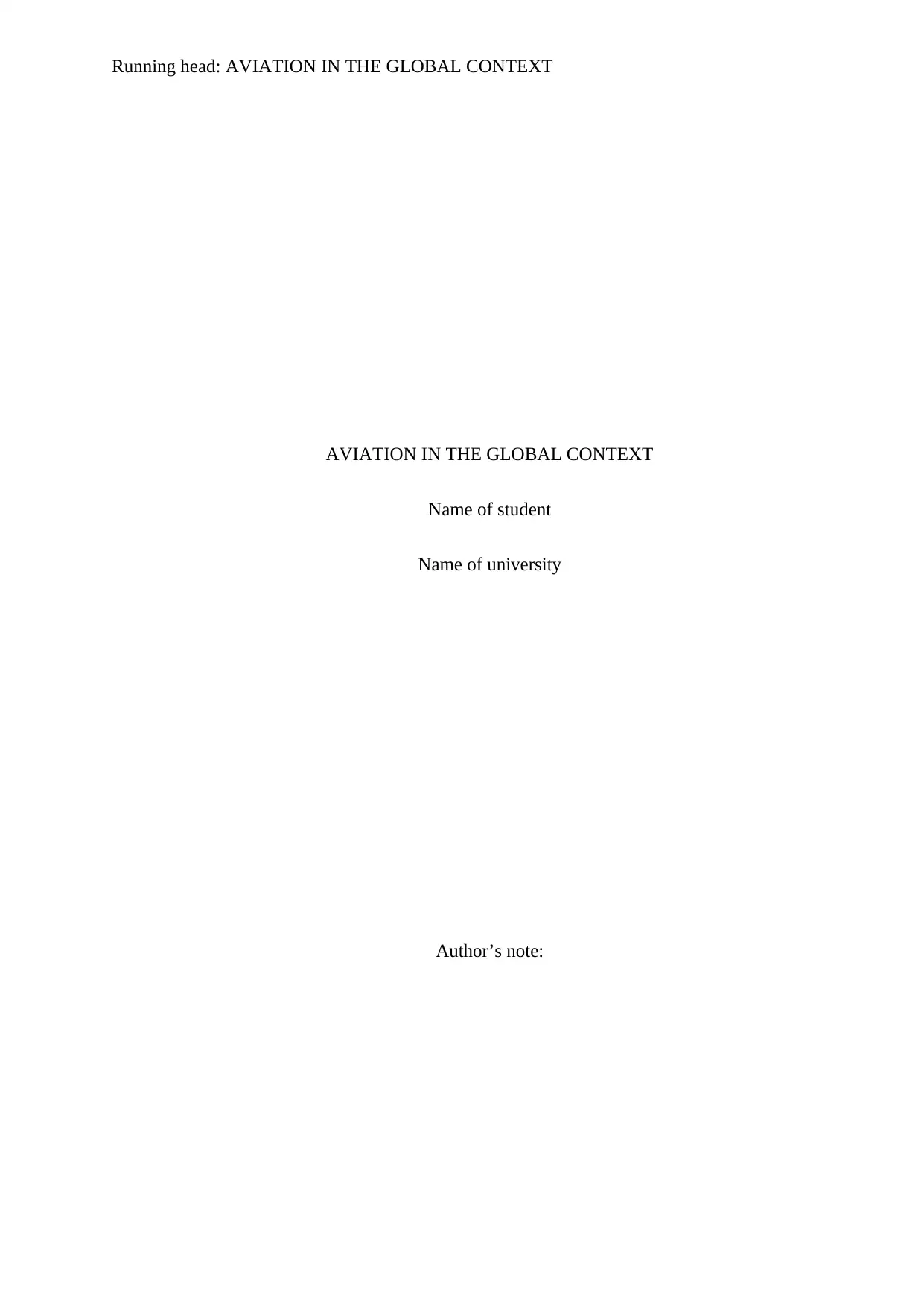
Running head: AVIATION IN THE GLOBAL CONTEXT
AVIATION IN THE GLOBAL CONTEXT
Name of student
Name of university
Author’s note:
AVIATION IN THE GLOBAL CONTEXT
Name of student
Name of university
Author’s note:
Paraphrase This Document
Need a fresh take? Get an instant paraphrase of this document with our AI Paraphraser
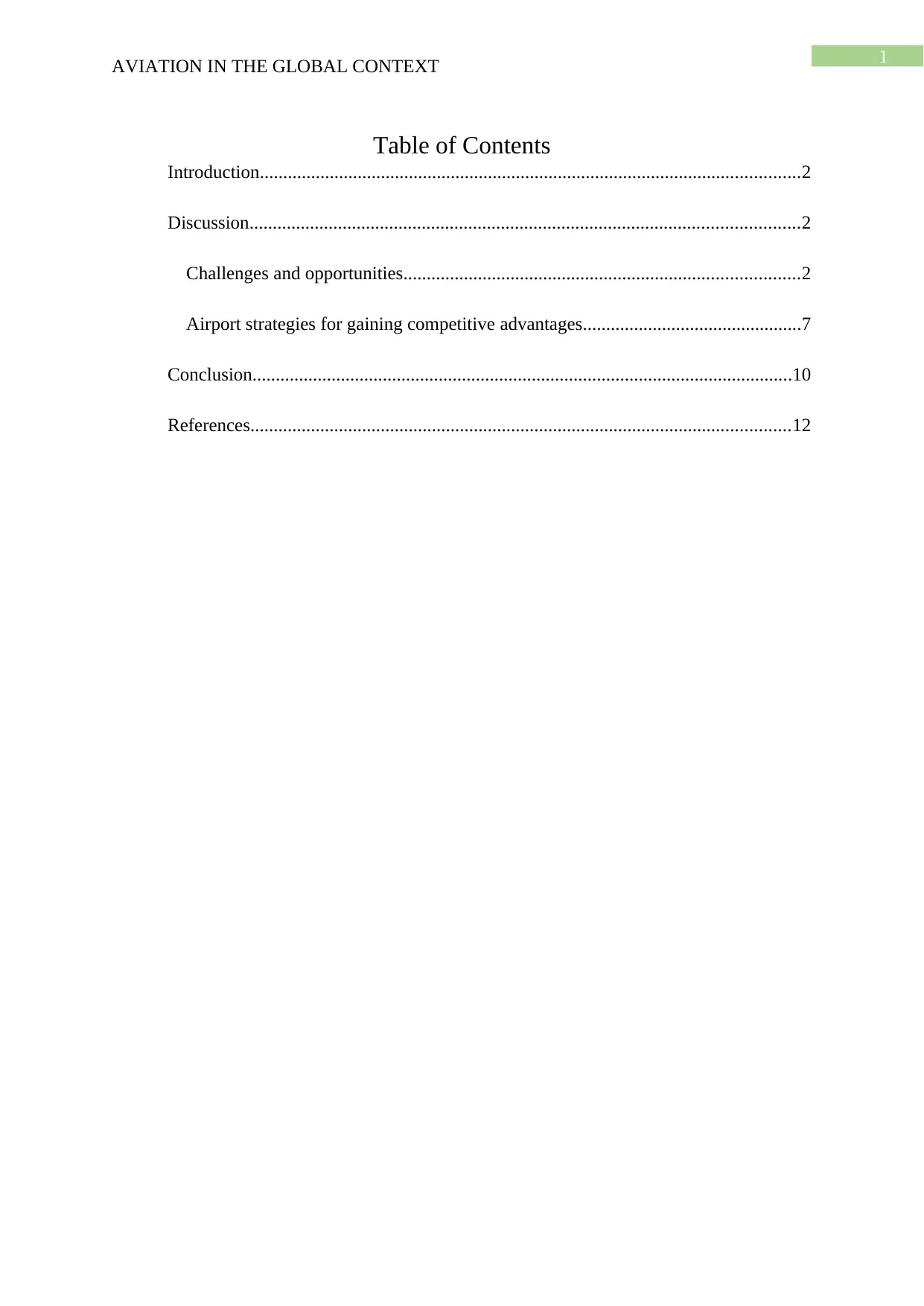
1
AVIATION IN THE GLOBAL CONTEXT
Table of Contents
Introduction....................................................................................................................2
Discussion......................................................................................................................2
Challenges and opportunities.....................................................................................2
Airport strategies for gaining competitive advantages...............................................7
Conclusion....................................................................................................................10
References....................................................................................................................12
AVIATION IN THE GLOBAL CONTEXT
Table of Contents
Introduction....................................................................................................................2
Discussion......................................................................................................................2
Challenges and opportunities.....................................................................................2
Airport strategies for gaining competitive advantages...............................................7
Conclusion....................................................................................................................10
References....................................................................................................................12
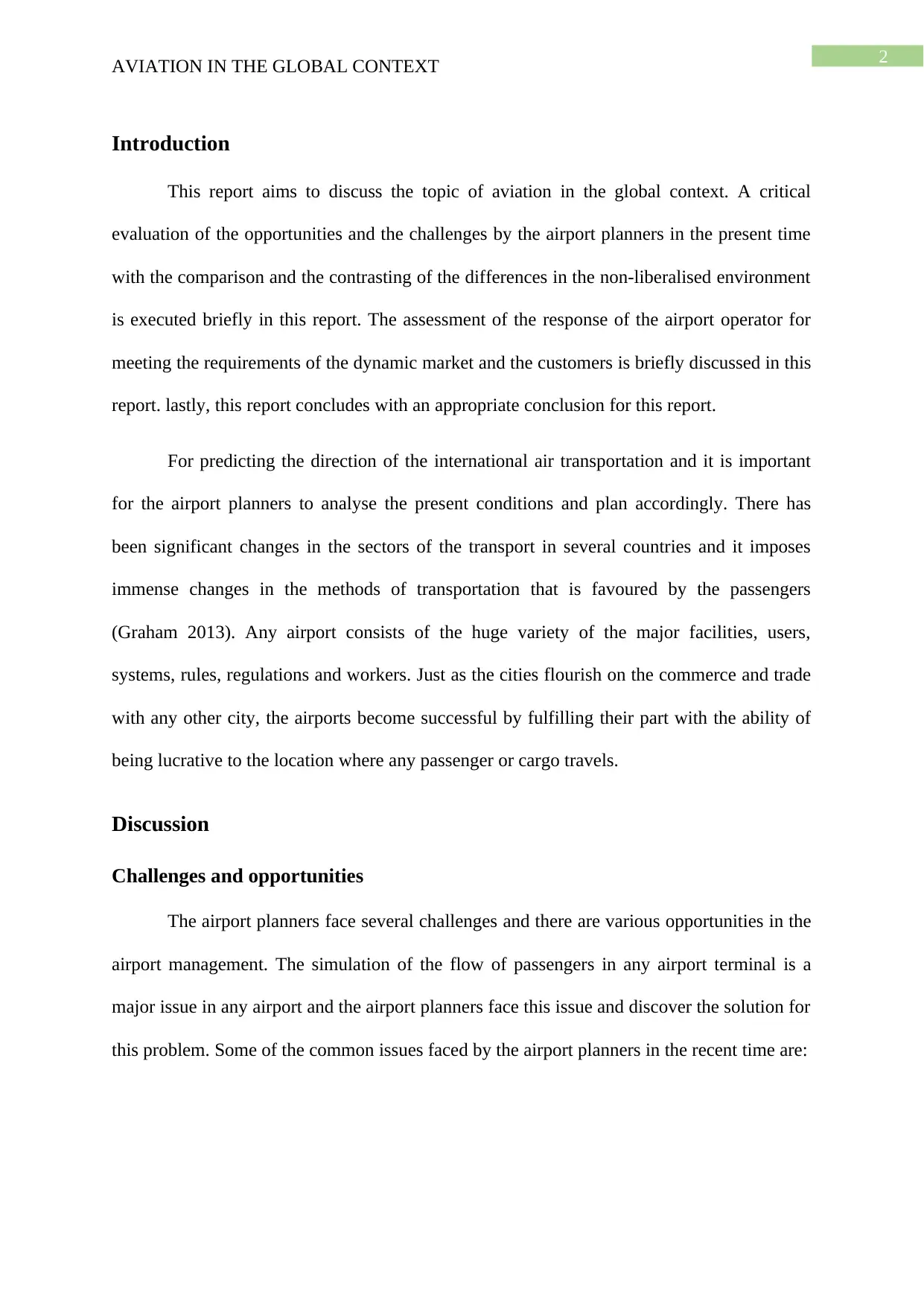
2
AVIATION IN THE GLOBAL CONTEXT
Introduction
This report aims to discuss the topic of aviation in the global context. A critical
evaluation of the opportunities and the challenges by the airport planners in the present time
with the comparison and the contrasting of the differences in the non-liberalised environment
is executed briefly in this report. The assessment of the response of the airport operator for
meeting the requirements of the dynamic market and the customers is briefly discussed in this
report. lastly, this report concludes with an appropriate conclusion for this report.
For predicting the direction of the international air transportation and it is important
for the airport planners to analyse the present conditions and plan accordingly. There has
been significant changes in the sectors of the transport in several countries and it imposes
immense changes in the methods of transportation that is favoured by the passengers
(Graham 2013). Any airport consists of the huge variety of the major facilities, users,
systems, rules, regulations and workers. Just as the cities flourish on the commerce and trade
with any other city, the airports become successful by fulfilling their part with the ability of
being lucrative to the location where any passenger or cargo travels.
Discussion
Challenges and opportunities
The airport planners face several challenges and there are various opportunities in the
airport management. The simulation of the flow of passengers in any airport terminal is a
major issue in any airport and the airport planners face this issue and discover the solution for
this problem. Some of the common issues faced by the airport planners in the recent time are:
AVIATION IN THE GLOBAL CONTEXT
Introduction
This report aims to discuss the topic of aviation in the global context. A critical
evaluation of the opportunities and the challenges by the airport planners in the present time
with the comparison and the contrasting of the differences in the non-liberalised environment
is executed briefly in this report. The assessment of the response of the airport operator for
meeting the requirements of the dynamic market and the customers is briefly discussed in this
report. lastly, this report concludes with an appropriate conclusion for this report.
For predicting the direction of the international air transportation and it is important
for the airport planners to analyse the present conditions and plan accordingly. There has
been significant changes in the sectors of the transport in several countries and it imposes
immense changes in the methods of transportation that is favoured by the passengers
(Graham 2013). Any airport consists of the huge variety of the major facilities, users,
systems, rules, regulations and workers. Just as the cities flourish on the commerce and trade
with any other city, the airports become successful by fulfilling their part with the ability of
being lucrative to the location where any passenger or cargo travels.
Discussion
Challenges and opportunities
The airport planners face several challenges and there are various opportunities in the
airport management. The simulation of the flow of passengers in any airport terminal is a
major issue in any airport and the airport planners face this issue and discover the solution for
this problem. Some of the common issues faced by the airport planners in the recent time are:
⊘ This is a preview!⊘
Do you want full access?
Subscribe today to unlock all pages.

Trusted by 1+ million students worldwide
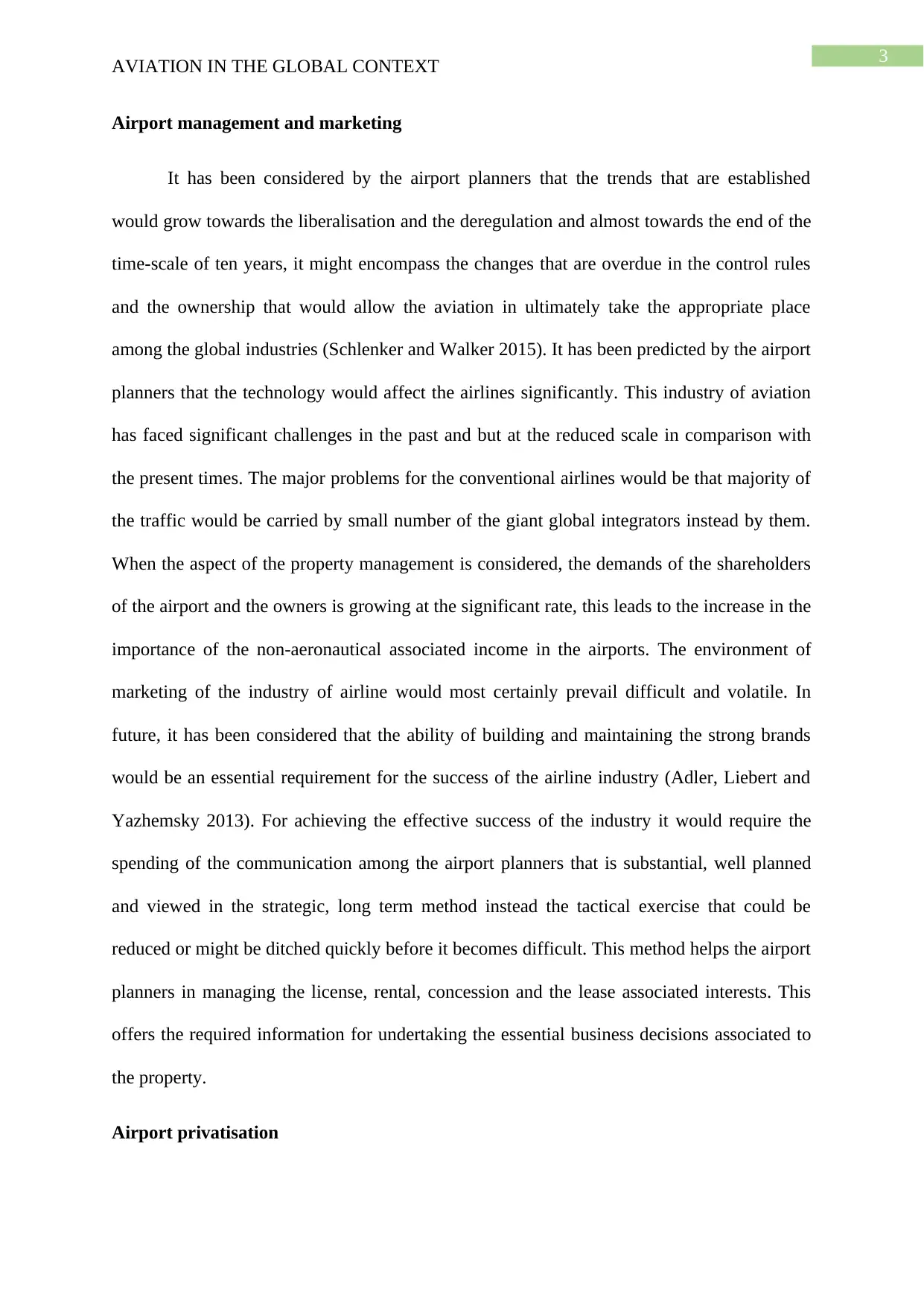
3
AVIATION IN THE GLOBAL CONTEXT
Airport management and marketing
It has been considered by the airport planners that the trends that are established
would grow towards the liberalisation and the deregulation and almost towards the end of the
time-scale of ten years, it might encompass the changes that are overdue in the control rules
and the ownership that would allow the aviation in ultimately take the appropriate place
among the global industries (Schlenker and Walker 2015). It has been predicted by the airport
planners that the technology would affect the airlines significantly. This industry of aviation
has faced significant challenges in the past and but at the reduced scale in comparison with
the present times. The major problems for the conventional airlines would be that majority of
the traffic would be carried by small number of the giant global integrators instead by them.
When the aspect of the property management is considered, the demands of the shareholders
of the airport and the owners is growing at the significant rate, this leads to the increase in the
importance of the non-aeronautical associated income in the airports. The environment of
marketing of the industry of airline would most certainly prevail difficult and volatile. In
future, it has been considered that the ability of building and maintaining the strong brands
would be an essential requirement for the success of the airline industry (Adler, Liebert and
Yazhemsky 2013). For achieving the effective success of the industry it would require the
spending of the communication among the airport planners that is substantial, well planned
and viewed in the strategic, long term method instead the tactical exercise that could be
reduced or might be ditched quickly before it becomes difficult. This method helps the airport
planners in managing the license, rental, concession and the lease associated interests. This
offers the required information for undertaking the essential business decisions associated to
the property.
Airport privatisation
AVIATION IN THE GLOBAL CONTEXT
Airport management and marketing
It has been considered by the airport planners that the trends that are established
would grow towards the liberalisation and the deregulation and almost towards the end of the
time-scale of ten years, it might encompass the changes that are overdue in the control rules
and the ownership that would allow the aviation in ultimately take the appropriate place
among the global industries (Schlenker and Walker 2015). It has been predicted by the airport
planners that the technology would affect the airlines significantly. This industry of aviation
has faced significant challenges in the past and but at the reduced scale in comparison with
the present times. The major problems for the conventional airlines would be that majority of
the traffic would be carried by small number of the giant global integrators instead by them.
When the aspect of the property management is considered, the demands of the shareholders
of the airport and the owners is growing at the significant rate, this leads to the increase in the
importance of the non-aeronautical associated income in the airports. The environment of
marketing of the industry of airline would most certainly prevail difficult and volatile. In
future, it has been considered that the ability of building and maintaining the strong brands
would be an essential requirement for the success of the airline industry (Adler, Liebert and
Yazhemsky 2013). For achieving the effective success of the industry it would require the
spending of the communication among the airport planners that is substantial, well planned
and viewed in the strategic, long term method instead the tactical exercise that could be
reduced or might be ditched quickly before it becomes difficult. This method helps the airport
planners in managing the license, rental, concession and the lease associated interests. This
offers the required information for undertaking the essential business decisions associated to
the property.
Airport privatisation
Paraphrase This Document
Need a fresh take? Get an instant paraphrase of this document with our AI Paraphraser

4
AVIATION IN THE GLOBAL CONTEXT
It has been discovered by the airport planners that the airports are increasingly relied
on private sector for providing the services as the method of reducing the costs and then
improving the range and quality of the services that are provided. The aspect of the
privatisation refers to the altering responsibilities and functions of the government that might
be completely or partly for private sector (Lozano, Gutiérrez and Moreno 2013). Most of the
services that are presently performed at the large commercial airports like the airline
ticketing, cleaning, retail concessions and the aspect of the ground transportation are majorly
provided by the private firms. Even post privatisation, the airports might be the subject to the
regulations of the government about the airline access, airport charges to the airlines,
security, protection of the environment and the safety. The privatisation advocates the belief
that the private firms will provide the extra capital for the development, the privatised
airports will be increasingly profitable due to the private sector that would operate these
airports with increased efficiency and it backs the belief that the privatisation will financially
provide benefit to all the levels of the government by the reduction of the demand on the
public funds and then increasing the base of the tax (Zhang et al. 2017). Moreover, the basic
that majorly drives the private enterprises towards the efficient and competitive operations
are increasingly becoming comprised by the publicly managed and owned airports. This leads
to the efficient structures and management of the executives for managing the responsibilities
has led to the increasingly streamlined and efficient structures of the organisations of airport
management that could visualise the solutions for future problems and the issues for reaching
the objectives of the airports.
Relations of the airport airline
Almost all the airports and airlines are operated and owned by subdivisions of the
state government or the state governments like the cities, countries or the airport authorities.
Unlike the railroads, bus lines and the freight carriers that should own their terminals, the
AVIATION IN THE GLOBAL CONTEXT
It has been discovered by the airport planners that the airports are increasingly relied
on private sector for providing the services as the method of reducing the costs and then
improving the range and quality of the services that are provided. The aspect of the
privatisation refers to the altering responsibilities and functions of the government that might
be completely or partly for private sector (Lozano, Gutiérrez and Moreno 2013). Most of the
services that are presently performed at the large commercial airports like the airline
ticketing, cleaning, retail concessions and the aspect of the ground transportation are majorly
provided by the private firms. Even post privatisation, the airports might be the subject to the
regulations of the government about the airline access, airport charges to the airlines,
security, protection of the environment and the safety. The privatisation advocates the belief
that the private firms will provide the extra capital for the development, the privatised
airports will be increasingly profitable due to the private sector that would operate these
airports with increased efficiency and it backs the belief that the privatisation will financially
provide benefit to all the levels of the government by the reduction of the demand on the
public funds and then increasing the base of the tax (Zhang et al. 2017). Moreover, the basic
that majorly drives the private enterprises towards the efficient and competitive operations
are increasingly becoming comprised by the publicly managed and owned airports. This leads
to the efficient structures and management of the executives for managing the responsibilities
has led to the increasingly streamlined and efficient structures of the organisations of airport
management that could visualise the solutions for future problems and the issues for reaching
the objectives of the airports.
Relations of the airport airline
Almost all the airports and airlines are operated and owned by subdivisions of the
state government or the state governments like the cities, countries or the airport authorities.
Unlike the railroads, bus lines and the freight carriers that should own their terminals, the
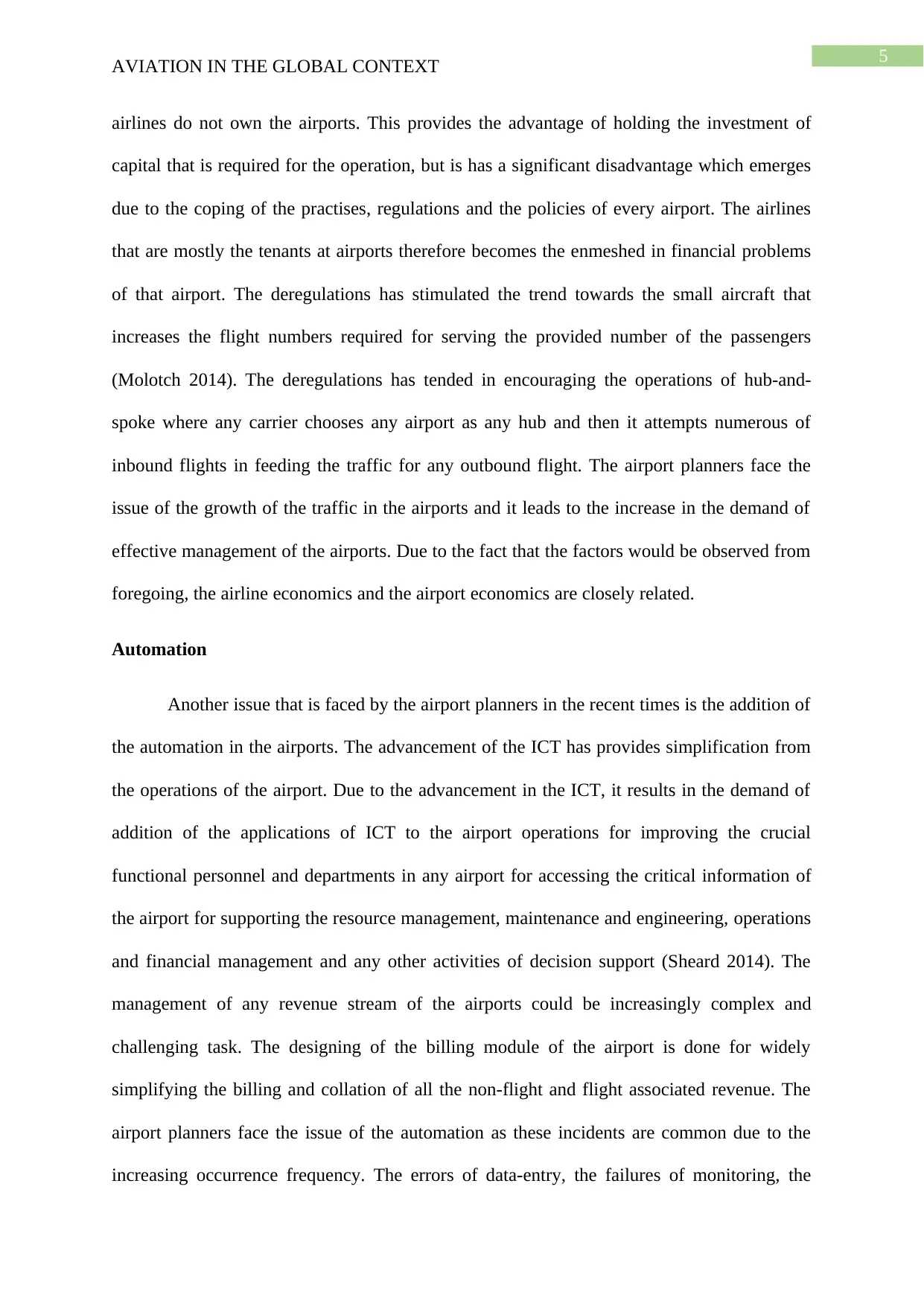
5
AVIATION IN THE GLOBAL CONTEXT
airlines do not own the airports. This provides the advantage of holding the investment of
capital that is required for the operation, but is has a significant disadvantage which emerges
due to the coping of the practises, regulations and the policies of every airport. The airlines
that are mostly the tenants at airports therefore becomes the enmeshed in financial problems
of that airport. The deregulations has stimulated the trend towards the small aircraft that
increases the flight numbers required for serving the provided number of the passengers
(Molotch 2014). The deregulations has tended in encouraging the operations of hub-and-
spoke where any carrier chooses any airport as any hub and then it attempts numerous of
inbound flights in feeding the traffic for any outbound flight. The airport planners face the
issue of the growth of the traffic in the airports and it leads to the increase in the demand of
effective management of the airports. Due to the fact that the factors would be observed from
foregoing, the airline economics and the airport economics are closely related.
Automation
Another issue that is faced by the airport planners in the recent times is the addition of
the automation in the airports. The advancement of the ICT has provides simplification from
the operations of the airport. Due to the advancement in the ICT, it results in the demand of
addition of the applications of ICT to the airport operations for improving the crucial
functional personnel and departments in any airport for accessing the critical information of
the airport for supporting the resource management, maintenance and engineering, operations
and financial management and any other activities of decision support (Sheard 2014). The
management of any revenue stream of the airports could be increasingly complex and
challenging task. The designing of the billing module of the airport is done for widely
simplifying the billing and collation of all the non-flight and flight associated revenue. The
airport planners face the issue of the automation as these incidents are common due to the
increasing occurrence frequency. The errors of data-entry, the failures of monitoring, the
AVIATION IN THE GLOBAL CONTEXT
airlines do not own the airports. This provides the advantage of holding the investment of
capital that is required for the operation, but is has a significant disadvantage which emerges
due to the coping of the practises, regulations and the policies of every airport. The airlines
that are mostly the tenants at airports therefore becomes the enmeshed in financial problems
of that airport. The deregulations has stimulated the trend towards the small aircraft that
increases the flight numbers required for serving the provided number of the passengers
(Molotch 2014). The deregulations has tended in encouraging the operations of hub-and-
spoke where any carrier chooses any airport as any hub and then it attempts numerous of
inbound flights in feeding the traffic for any outbound flight. The airport planners face the
issue of the growth of the traffic in the airports and it leads to the increase in the demand of
effective management of the airports. Due to the fact that the factors would be observed from
foregoing, the airline economics and the airport economics are closely related.
Automation
Another issue that is faced by the airport planners in the recent times is the addition of
the automation in the airports. The advancement of the ICT has provides simplification from
the operations of the airport. Due to the advancement in the ICT, it results in the demand of
addition of the applications of ICT to the airport operations for improving the crucial
functional personnel and departments in any airport for accessing the critical information of
the airport for supporting the resource management, maintenance and engineering, operations
and financial management and any other activities of decision support (Sheard 2014). The
management of any revenue stream of the airports could be increasingly complex and
challenging task. The designing of the billing module of the airport is done for widely
simplifying the billing and collation of all the non-flight and flight associated revenue. The
airport planners face the issue of the automation as these incidents are common due to the
increasing occurrence frequency. The errors of data-entry, the failures of monitoring, the
⊘ This is a preview!⊘
Do you want full access?
Subscribe today to unlock all pages.

Trusted by 1+ million students worldwide
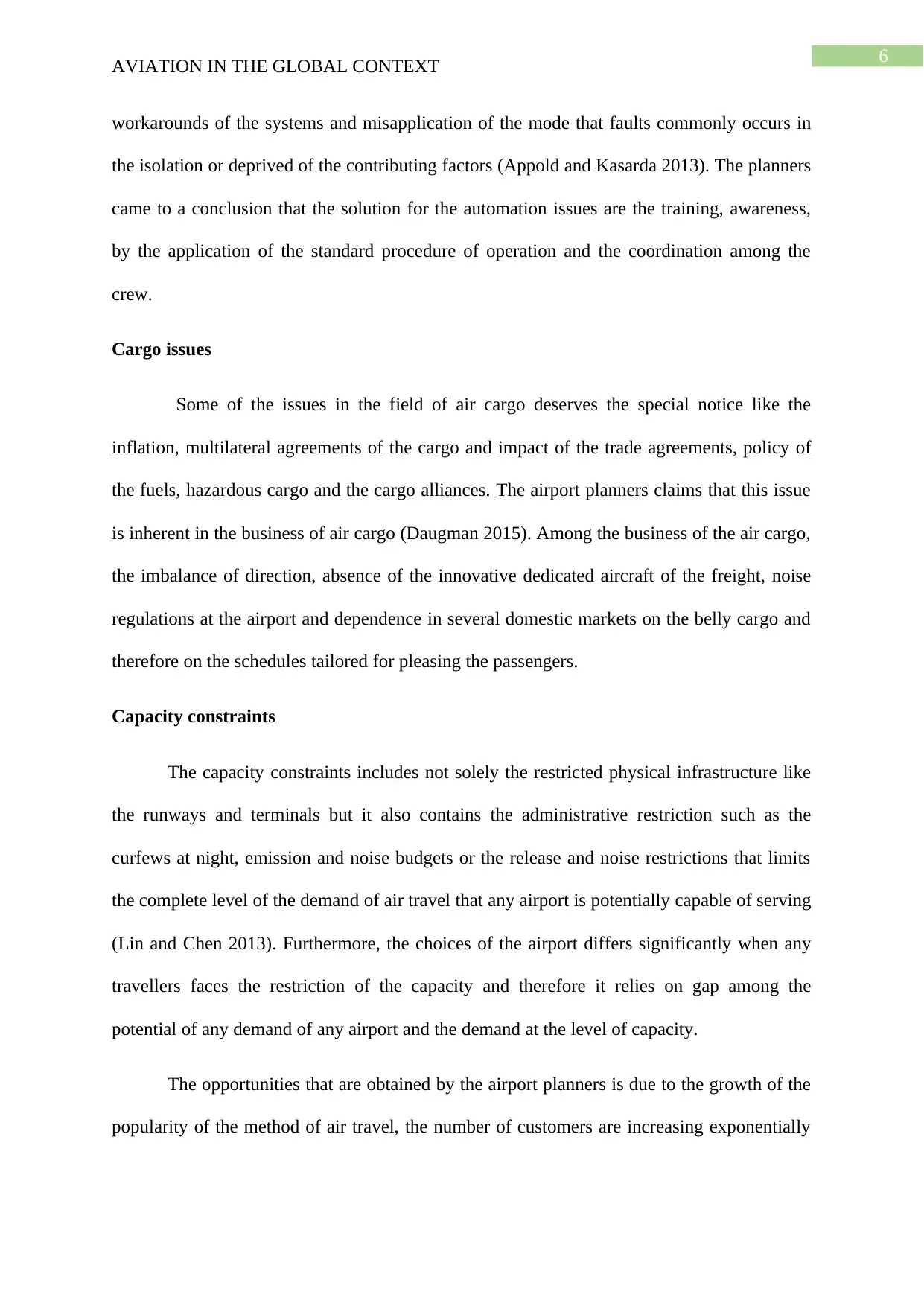
6
AVIATION IN THE GLOBAL CONTEXT
workarounds of the systems and misapplication of the mode that faults commonly occurs in
the isolation or deprived of the contributing factors (Appold and Kasarda 2013). The planners
came to a conclusion that the solution for the automation issues are the training, awareness,
by the application of the standard procedure of operation and the coordination among the
crew.
Cargo issues
Some of the issues in the field of air cargo deserves the special notice like the
inflation, multilateral agreements of the cargo and impact of the trade agreements, policy of
the fuels, hazardous cargo and the cargo alliances. The airport planners claims that this issue
is inherent in the business of air cargo (Daugman 2015). Among the business of the air cargo,
the imbalance of direction, absence of the innovative dedicated aircraft of the freight, noise
regulations at the airport and dependence in several domestic markets on the belly cargo and
therefore on the schedules tailored for pleasing the passengers.
Capacity constraints
The capacity constraints includes not solely the restricted physical infrastructure like
the runways and terminals but it also contains the administrative restriction such as the
curfews at night, emission and noise budgets or the release and noise restrictions that limits
the complete level of the demand of air travel that any airport is potentially capable of serving
(Lin and Chen 2013). Furthermore, the choices of the airport differs significantly when any
travellers faces the restriction of the capacity and therefore it relies on gap among the
potential of any demand of any airport and the demand at the level of capacity.
The opportunities that are obtained by the airport planners is due to the growth of the
popularity of the method of air travel, the number of customers are increasing exponentially
AVIATION IN THE GLOBAL CONTEXT
workarounds of the systems and misapplication of the mode that faults commonly occurs in
the isolation or deprived of the contributing factors (Appold and Kasarda 2013). The planners
came to a conclusion that the solution for the automation issues are the training, awareness,
by the application of the standard procedure of operation and the coordination among the
crew.
Cargo issues
Some of the issues in the field of air cargo deserves the special notice like the
inflation, multilateral agreements of the cargo and impact of the trade agreements, policy of
the fuels, hazardous cargo and the cargo alliances. The airport planners claims that this issue
is inherent in the business of air cargo (Daugman 2015). Among the business of the air cargo,
the imbalance of direction, absence of the innovative dedicated aircraft of the freight, noise
regulations at the airport and dependence in several domestic markets on the belly cargo and
therefore on the schedules tailored for pleasing the passengers.
Capacity constraints
The capacity constraints includes not solely the restricted physical infrastructure like
the runways and terminals but it also contains the administrative restriction such as the
curfews at night, emission and noise budgets or the release and noise restrictions that limits
the complete level of the demand of air travel that any airport is potentially capable of serving
(Lin and Chen 2013). Furthermore, the choices of the airport differs significantly when any
travellers faces the restriction of the capacity and therefore it relies on gap among the
potential of any demand of any airport and the demand at the level of capacity.
The opportunities that are obtained by the airport planners is due to the growth of the
popularity of the method of air travel, the number of customers are increasing exponentially
Paraphrase This Document
Need a fresh take? Get an instant paraphrase of this document with our AI Paraphraser
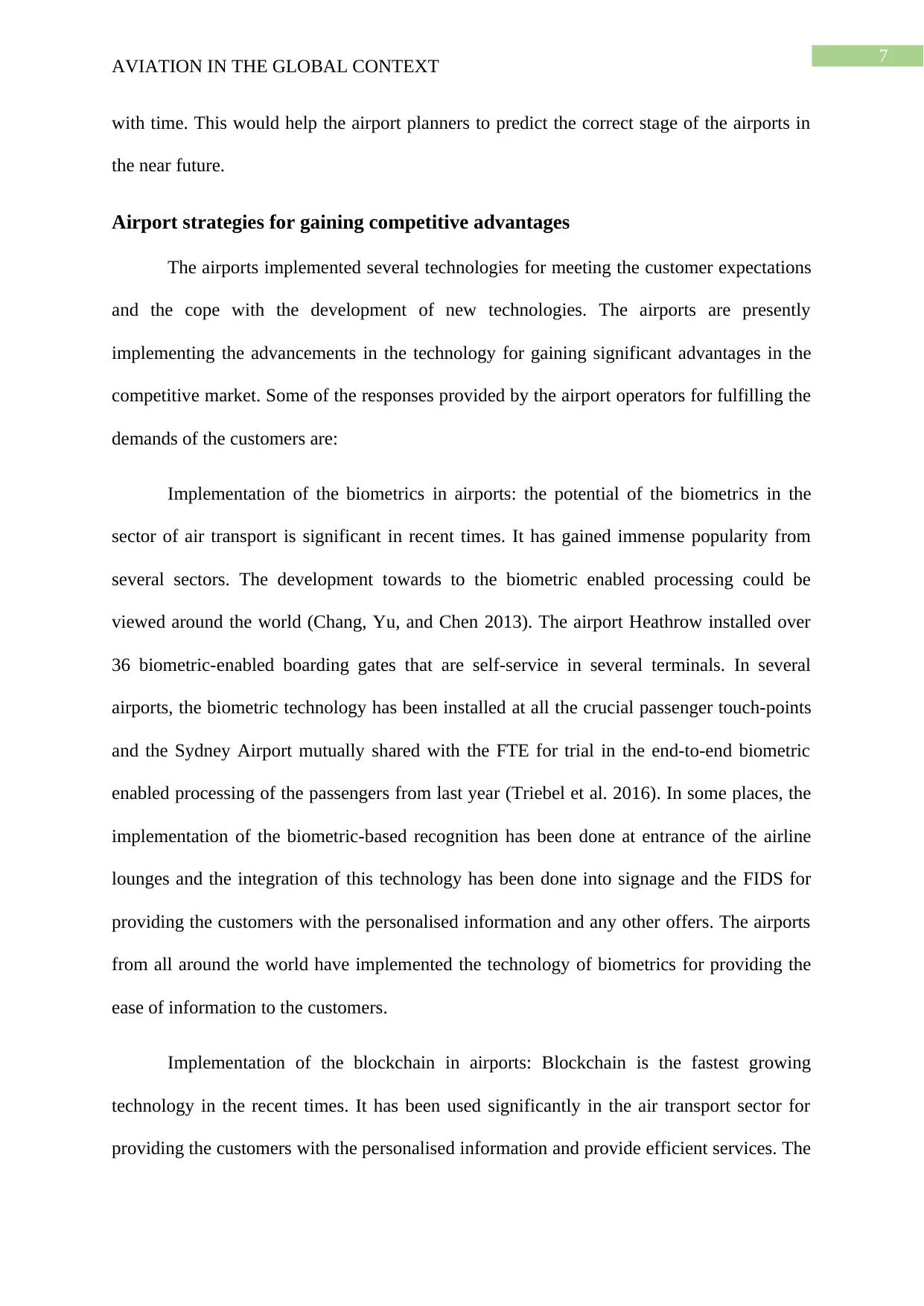
7
AVIATION IN THE GLOBAL CONTEXT
with time. This would help the airport planners to predict the correct stage of the airports in
the near future.
Airport strategies for gaining competitive advantages
The airports implemented several technologies for meeting the customer expectations
and the cope with the development of new technologies. The airports are presently
implementing the advancements in the technology for gaining significant advantages in the
competitive market. Some of the responses provided by the airport operators for fulfilling the
demands of the customers are:
Implementation of the biometrics in airports: the potential of the biometrics in the
sector of air transport is significant in recent times. It has gained immense popularity from
several sectors. The development towards to the biometric enabled processing could be
viewed around the world (Chang, Yu, and Chen 2013). The airport Heathrow installed over
36 biometric-enabled boarding gates that are self-service in several terminals. In several
airports, the biometric technology has been installed at all the crucial passenger touch-points
and the Sydney Airport mutually shared with the FTE for trial in the end-to-end biometric
enabled processing of the passengers from last year (Triebel et al. 2016). In some places, the
implementation of the biometric-based recognition has been done at entrance of the airline
lounges and the integration of this technology has been done into signage and the FIDS for
providing the customers with the personalised information and any other offers. The airports
from all around the world have implemented the technology of biometrics for providing the
ease of information to the customers.
Implementation of the blockchain in airports: Blockchain is the fastest growing
technology in the recent times. It has been used significantly in the air transport sector for
providing the customers with the personalised information and provide efficient services. The
AVIATION IN THE GLOBAL CONTEXT
with time. This would help the airport planners to predict the correct stage of the airports in
the near future.
Airport strategies for gaining competitive advantages
The airports implemented several technologies for meeting the customer expectations
and the cope with the development of new technologies. The airports are presently
implementing the advancements in the technology for gaining significant advantages in the
competitive market. Some of the responses provided by the airport operators for fulfilling the
demands of the customers are:
Implementation of the biometrics in airports: the potential of the biometrics in the
sector of air transport is significant in recent times. It has gained immense popularity from
several sectors. The development towards to the biometric enabled processing could be
viewed around the world (Chang, Yu, and Chen 2013). The airport Heathrow installed over
36 biometric-enabled boarding gates that are self-service in several terminals. In several
airports, the biometric technology has been installed at all the crucial passenger touch-points
and the Sydney Airport mutually shared with the FTE for trial in the end-to-end biometric
enabled processing of the passengers from last year (Triebel et al. 2016). In some places, the
implementation of the biometric-based recognition has been done at entrance of the airline
lounges and the integration of this technology has been done into signage and the FIDS for
providing the customers with the personalised information and any other offers. The airports
from all around the world have implemented the technology of biometrics for providing the
ease of information to the customers.
Implementation of the blockchain in airports: Blockchain is the fastest growing
technology in the recent times. It has been used significantly in the air transport sector for
providing the customers with the personalised information and provide efficient services. The
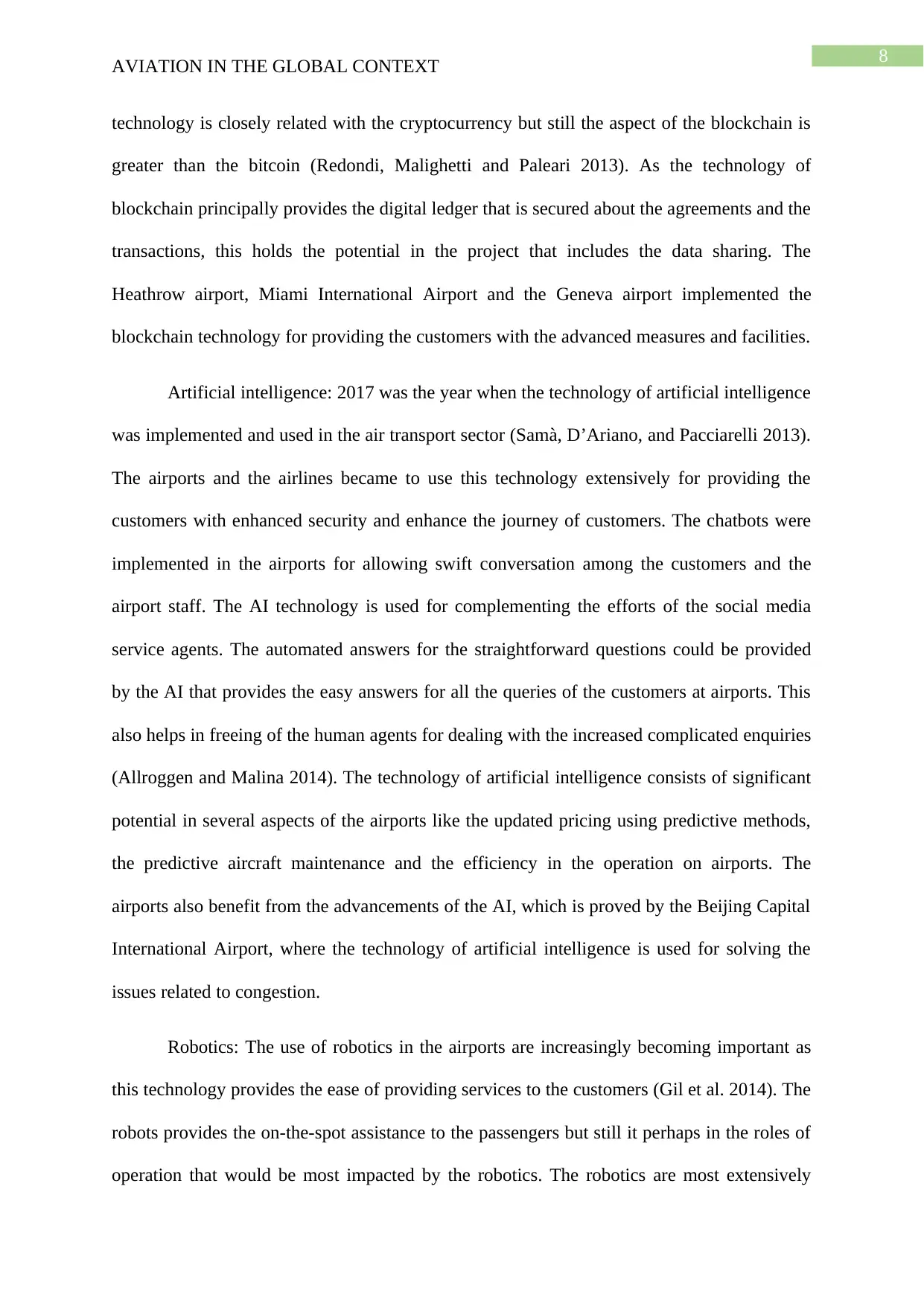
8
AVIATION IN THE GLOBAL CONTEXT
technology is closely related with the cryptocurrency but still the aspect of the blockchain is
greater than the bitcoin (Redondi, Malighetti and Paleari 2013). As the technology of
blockchain principally provides the digital ledger that is secured about the agreements and the
transactions, this holds the potential in the project that includes the data sharing. The
Heathrow airport, Miami International Airport and the Geneva airport implemented the
blockchain technology for providing the customers with the advanced measures and facilities.
Artificial intelligence: 2017 was the year when the technology of artificial intelligence
was implemented and used in the air transport sector (Samà, D’Ariano, and Pacciarelli 2013).
The airports and the airlines became to use this technology extensively for providing the
customers with enhanced security and enhance the journey of customers. The chatbots were
implemented in the airports for allowing swift conversation among the customers and the
airport staff. The AI technology is used for complementing the efforts of the social media
service agents. The automated answers for the straightforward questions could be provided
by the AI that provides the easy answers for all the queries of the customers at airports. This
also helps in freeing of the human agents for dealing with the increased complicated enquiries
(Allroggen and Malina 2014). The technology of artificial intelligence consists of significant
potential in several aspects of the airports like the updated pricing using predictive methods,
the predictive aircraft maintenance and the efficiency in the operation on airports. The
airports also benefit from the advancements of the AI, which is proved by the Beijing Capital
International Airport, where the technology of artificial intelligence is used for solving the
issues related to congestion.
Robotics: The use of robotics in the airports are increasingly becoming important as
this technology provides the ease of providing services to the customers (Gil et al. 2014). The
robots provides the on-the-spot assistance to the passengers but still it perhaps in the roles of
operation that would be most impacted by the robotics. The robotics are most extensively
AVIATION IN THE GLOBAL CONTEXT
technology is closely related with the cryptocurrency but still the aspect of the blockchain is
greater than the bitcoin (Redondi, Malighetti and Paleari 2013). As the technology of
blockchain principally provides the digital ledger that is secured about the agreements and the
transactions, this holds the potential in the project that includes the data sharing. The
Heathrow airport, Miami International Airport and the Geneva airport implemented the
blockchain technology for providing the customers with the advanced measures and facilities.
Artificial intelligence: 2017 was the year when the technology of artificial intelligence
was implemented and used in the air transport sector (Samà, D’Ariano, and Pacciarelli 2013).
The airports and the airlines became to use this technology extensively for providing the
customers with enhanced security and enhance the journey of customers. The chatbots were
implemented in the airports for allowing swift conversation among the customers and the
airport staff. The AI technology is used for complementing the efforts of the social media
service agents. The automated answers for the straightforward questions could be provided
by the AI that provides the easy answers for all the queries of the customers at airports. This
also helps in freeing of the human agents for dealing with the increased complicated enquiries
(Allroggen and Malina 2014). The technology of artificial intelligence consists of significant
potential in several aspects of the airports like the updated pricing using predictive methods,
the predictive aircraft maintenance and the efficiency in the operation on airports. The
airports also benefit from the advancements of the AI, which is proved by the Beijing Capital
International Airport, where the technology of artificial intelligence is used for solving the
issues related to congestion.
Robotics: The use of robotics in the airports are increasingly becoming important as
this technology provides the ease of providing services to the customers (Gil et al. 2014). The
robots provides the on-the-spot assistance to the passengers but still it perhaps in the roles of
operation that would be most impacted by the robotics. The robotics are most extensively
⊘ This is a preview!⊘
Do you want full access?
Subscribe today to unlock all pages.

Trusted by 1+ million students worldwide

9
AVIATION IN THE GLOBAL CONTEXT
used in the airports of the country Japan where it is used for providing the real time assistance
to the customers and the passengers. These robots could perform various tasks that ranges
from the transportation of the luggage to the proactively identification of the potential risks in
the security of airport (Stewart and Mueller 2014). The final goal is the deployment of the
fleets of the robots in the terminal for gaining competitive advantage in the air transport
sector. It is commonly perceived by several researchers and airport authorities that the use of
the robotics in the effective handling of the baggage could be done more easily with robotics
and it could be transformed by the replacement of the centralised conveyor and then track and
tray the systems with the system built around the transportation robots of individual baggage
(Bilotkach 2015).
Baggage: The technological advancements are helping significantly in the
development of the enhanced baggage space. The bag drop using the self-service is presently
vastly used in the airports all around the world. The implementation of the electronic bag-tag
is widely done for processing the baggage claims at the airport.
Augmented reality: the use of AR, VR and the MR is widely done in the airports all
over the world as it provides the passengers with the ability of airport wayfinding and the
remote control centres in the airports. The Gatwick Airport unveiled the navigation using the
blue dot and the wayfinding using augmented reality that provides the passengers with the
ability of using the function of camera on their personal devices for viewing the augmented
reality directions for gaining an understanding of where they need to go (Merkert and Assaf
2015). Several other airports have implemented the technology of augmented reality for
enhancing the experience of the passengers and provide them with the ease of navigation to
the customers.
AVIATION IN THE GLOBAL CONTEXT
used in the airports of the country Japan where it is used for providing the real time assistance
to the customers and the passengers. These robots could perform various tasks that ranges
from the transportation of the luggage to the proactively identification of the potential risks in
the security of airport (Stewart and Mueller 2014). The final goal is the deployment of the
fleets of the robots in the terminal for gaining competitive advantage in the air transport
sector. It is commonly perceived by several researchers and airport authorities that the use of
the robotics in the effective handling of the baggage could be done more easily with robotics
and it could be transformed by the replacement of the centralised conveyor and then track and
tray the systems with the system built around the transportation robots of individual baggage
(Bilotkach 2015).
Baggage: The technological advancements are helping significantly in the
development of the enhanced baggage space. The bag drop using the self-service is presently
vastly used in the airports all around the world. The implementation of the electronic bag-tag
is widely done for processing the baggage claims at the airport.
Augmented reality: the use of AR, VR and the MR is widely done in the airports all
over the world as it provides the passengers with the ability of airport wayfinding and the
remote control centres in the airports. The Gatwick Airport unveiled the navigation using the
blue dot and the wayfinding using augmented reality that provides the passengers with the
ability of using the function of camera on their personal devices for viewing the augmented
reality directions for gaining an understanding of where they need to go (Merkert and Assaf
2015). Several other airports have implemented the technology of augmented reality for
enhancing the experience of the passengers and provide them with the ease of navigation to
the customers.
Paraphrase This Document
Need a fresh take? Get an instant paraphrase of this document with our AI Paraphraser
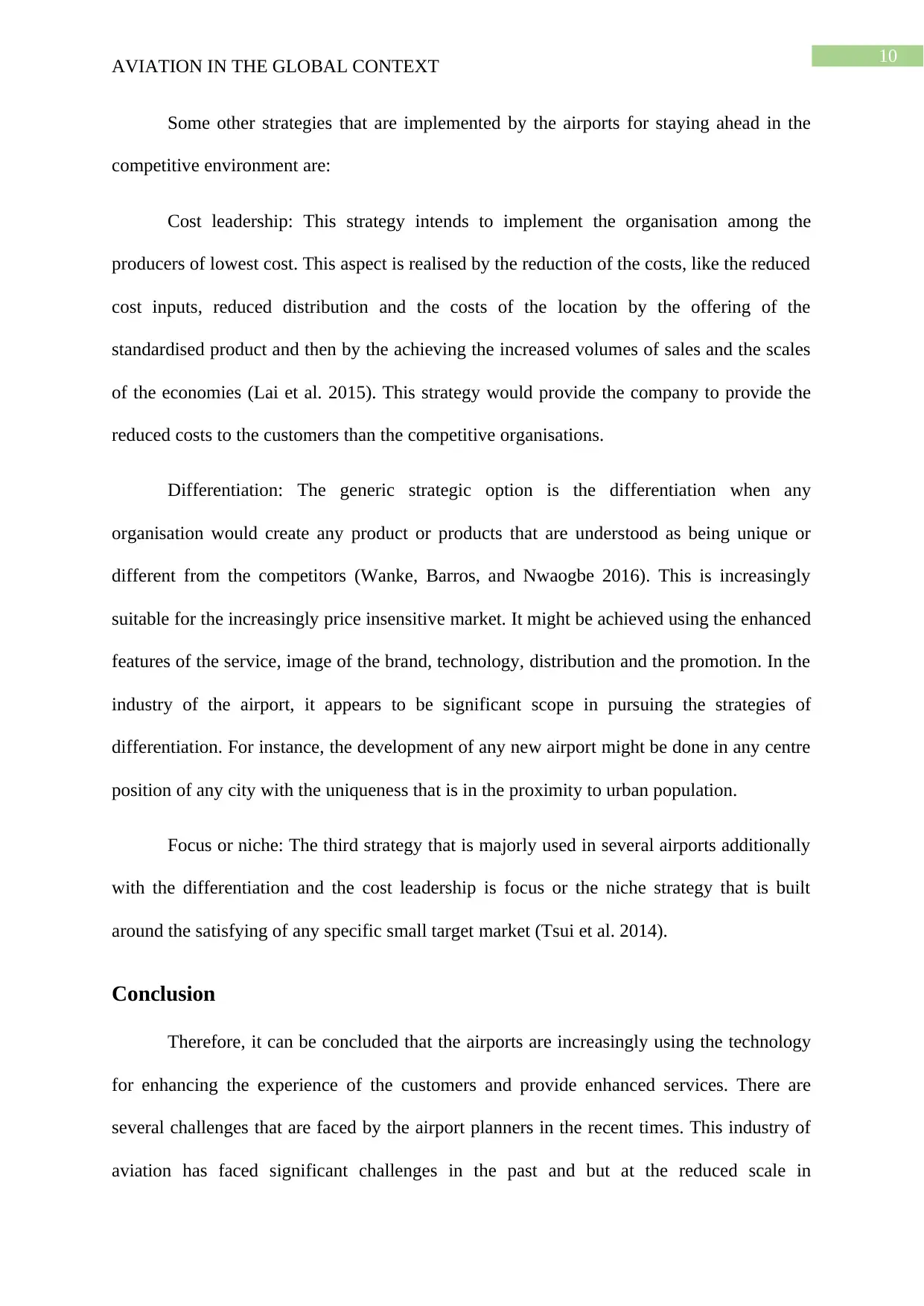
10
AVIATION IN THE GLOBAL CONTEXT
Some other strategies that are implemented by the airports for staying ahead in the
competitive environment are:
Cost leadership: This strategy intends to implement the organisation among the
producers of lowest cost. This aspect is realised by the reduction of the costs, like the reduced
cost inputs, reduced distribution and the costs of the location by the offering of the
standardised product and then by the achieving the increased volumes of sales and the scales
of the economies (Lai et al. 2015). This strategy would provide the company to provide the
reduced costs to the customers than the competitive organisations.
Differentiation: The generic strategic option is the differentiation when any
organisation would create any product or products that are understood as being unique or
different from the competitors (Wanke, Barros, and Nwaogbe 2016). This is increasingly
suitable for the increasingly price insensitive market. It might be achieved using the enhanced
features of the service, image of the brand, technology, distribution and the promotion. In the
industry of the airport, it appears to be significant scope in pursuing the strategies of
differentiation. For instance, the development of any new airport might be done in any centre
position of any city with the uniqueness that is in the proximity to urban population.
Focus or niche: The third strategy that is majorly used in several airports additionally
with the differentiation and the cost leadership is focus or the niche strategy that is built
around the satisfying of any specific small target market (Tsui et al. 2014).
Conclusion
Therefore, it can be concluded that the airports are increasingly using the technology
for enhancing the experience of the customers and provide enhanced services. There are
several challenges that are faced by the airport planners in the recent times. This industry of
aviation has faced significant challenges in the past and but at the reduced scale in
AVIATION IN THE GLOBAL CONTEXT
Some other strategies that are implemented by the airports for staying ahead in the
competitive environment are:
Cost leadership: This strategy intends to implement the organisation among the
producers of lowest cost. This aspect is realised by the reduction of the costs, like the reduced
cost inputs, reduced distribution and the costs of the location by the offering of the
standardised product and then by the achieving the increased volumes of sales and the scales
of the economies (Lai et al. 2015). This strategy would provide the company to provide the
reduced costs to the customers than the competitive organisations.
Differentiation: The generic strategic option is the differentiation when any
organisation would create any product or products that are understood as being unique or
different from the competitors (Wanke, Barros, and Nwaogbe 2016). This is increasingly
suitable for the increasingly price insensitive market. It might be achieved using the enhanced
features of the service, image of the brand, technology, distribution and the promotion. In the
industry of the airport, it appears to be significant scope in pursuing the strategies of
differentiation. For instance, the development of any new airport might be done in any centre
position of any city with the uniqueness that is in the proximity to urban population.
Focus or niche: The third strategy that is majorly used in several airports additionally
with the differentiation and the cost leadership is focus or the niche strategy that is built
around the satisfying of any specific small target market (Tsui et al. 2014).
Conclusion
Therefore, it can be concluded that the airports are increasingly using the technology
for enhancing the experience of the customers and provide enhanced services. There are
several challenges that are faced by the airport planners in the recent times. This industry of
aviation has faced significant challenges in the past and but at the reduced scale in

11
AVIATION IN THE GLOBAL CONTEXT
comparison with the present times. The major problems for the conventional airlines would
be that majority of the traffic would be carried by small number of the giant global integrators
instead of by them.It has been discovered by the airport planners that the airports are
increasingly relied on private sector for providing the services as the method of reducing the
costs and then improving the range and quality of the services that are provided. The aspect
of the privatisation refers to the altering responsibilities and functions of the government that
might be completely or partly for private sector. Almost all the airports and airlines are
operated and owned by subdivisions of the state government or the state governments like the
cities, countries or the airport authorities. Unlike the railroads, bus lines and the freight
carriers that should own their terminals, the airlines do not own the airports. Another issue
that is faced by the airport planners in the recent times is the addition of the automation in the
airports. The advancement of the ICT has provides simplification from the operations of the
airport. Some of the issues in the field of air cargo deserves the special notice like the
inflation, multilateral agreements of the cargo and impact of the trade agreements, policy of
the fuels, hazardous cargo and the cargo alliances. The capacity constraints includes not
solely the restricted physical infrastructure like the runways and terminals but it also contains
the administrative restriction such as the curfews at night, emission and noise budgets or the
release and noise restrictions that limits the complete level of the demand of air travel that
any airport is potentially capable of serving.
AVIATION IN THE GLOBAL CONTEXT
comparison with the present times. The major problems for the conventional airlines would
be that majority of the traffic would be carried by small number of the giant global integrators
instead of by them.It has been discovered by the airport planners that the airports are
increasingly relied on private sector for providing the services as the method of reducing the
costs and then improving the range and quality of the services that are provided. The aspect
of the privatisation refers to the altering responsibilities and functions of the government that
might be completely or partly for private sector. Almost all the airports and airlines are
operated and owned by subdivisions of the state government or the state governments like the
cities, countries or the airport authorities. Unlike the railroads, bus lines and the freight
carriers that should own their terminals, the airlines do not own the airports. Another issue
that is faced by the airport planners in the recent times is the addition of the automation in the
airports. The advancement of the ICT has provides simplification from the operations of the
airport. Some of the issues in the field of air cargo deserves the special notice like the
inflation, multilateral agreements of the cargo and impact of the trade agreements, policy of
the fuels, hazardous cargo and the cargo alliances. The capacity constraints includes not
solely the restricted physical infrastructure like the runways and terminals but it also contains
the administrative restriction such as the curfews at night, emission and noise budgets or the
release and noise restrictions that limits the complete level of the demand of air travel that
any airport is potentially capable of serving.
⊘ This is a preview!⊘
Do you want full access?
Subscribe today to unlock all pages.

Trusted by 1+ million students worldwide
1 out of 22
Related Documents
Your All-in-One AI-Powered Toolkit for Academic Success.
+13062052269
info@desklib.com
Available 24*7 on WhatsApp / Email
![[object Object]](/_next/static/media/star-bottom.7253800d.svg)
Unlock your academic potential
Copyright © 2020–2025 A2Z Services. All Rights Reserved. Developed and managed by ZUCOL.





